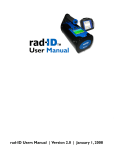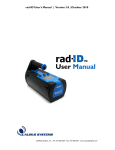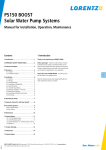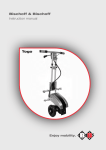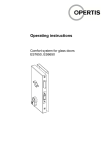Download Bischoff & Bischoff Rapid 2 Instruction manual
Transcript
Bischoff & Bischoff Instruction manual Rapid 2 / Paseo Enjoy mobility. Contents 1| Preface 1.1 Signs and symbols 2| Important safety instructions 2.1 General safety instructions 2.2 Information on EMC interference 2.3 Brakes 2.4 Safety in vehicles 2.5 Travelling in traffic 2.6 Purpose 2.7 Indications 2.8 Contraindications 2.9 Declaration of Conformity 3| Overview of product and accessories 3.1 Checking the delivery 3.2 Package 3.3 Overview 3.4 Basic adjustments 3.4.1 Steering column 3.4.2 Seat 3.4.3 Back rest 3.4.4 Arm rests 3.4.5 Seat belt 2 4 6 10 Paseo / Rapid 2 Bischoff & Bischoff GmbH • 04.05.2011 16 English 4| Using the scooter 4.1 Description of controls 4.2 Entering and leaving 4.3 Driving the scooter 4.4 Pushing the scooter 5| Technical Data 6| User care instructions 6.1 Cleaning and disinfection 6.2 Checking the brake system 6.2.1 Service brake 6.2.2 Drum brake 6.3 Lighting system 6.4 Battery 6.4.1 Charging 6.4.2 Replacing batteries 7| Maintenance instructions for dealers 8| Disposal 9| Transfer of the scooter 10| Maintenance 11| Warranty 12| Warranty — certificate 20 21 25 26 26 26 26 27 3 1. Preface Dear user, You have selected a high-quality scooter from Bischoff & Bischoff. Thank you for your trust in our products. The scooter has been designed to offer you many advantages and to meet your requirements. The wide range of adjustment options and the ease of setting the seat height, backrest angle and the distance to the handlebars makes it easy to adjust the scooter to fit your body size exactly. The scooter is designed exclusively for use outdoors. Please read the instruction manual carefully before operating your new scooter for the first time. The manual is an integral and important component of the scooter. Keep it where you can refer to it and if you sell the scooter give the manual to the new owner. Repairs and adjustments require special technical training and must therefore be conducted only by dealers authorised by Bischoff & Bischoff. 4 Paseo / Rapid 2 1.1 Signs and symbols. English Caution! Indicates specially safety-relevant instructions. Follow instruction manual. Important! Indicates specially useful information in the specific context. Bischoff & Bischoff GmbH • 04.05.2011 5 2. Important safety instructions 2.1 General safety instruction To prevent falls and dangerous situations, you should start familiarising yourself with your new scooter on a level, open area. We recommend having someone accompany you at this stage. Before operating the scooter please check that all attached parts are correctly fastened. Before driving the scooter practise operating it on a level and open area. Practise braking and accelerating to familiarise yourself with the behaviour of the scooter under braking and acceleration in a straight line and in curve. Please note that the stability of the scooter may be affected by movements of the body or the load and may increase the danger of tipping to one side. The scooter must not be used to transport more than one person or any loads. Note the intended use. Never operate the scooter under the influence of alcohol or other substances that may impair your attention and your physical and mental capacity. Always use ramps to drive over obstacles. Do not drive over an obstacle (step, curb) without using brakes. Be aware that the scooter may tip over when driving over rough areas, lifts and ramps. Make sure that there is sufficient clearance above, below and to the sides. The controls must always be switched off when you get on or off the scooter. Always follow the traffic regulations on public streets. 6 English Paseo / Rapid 2 The lights on the scooter must always be visible to other traffic. Wear bright, conspicuous clothing as much as possible. This will ensure that you are more visible to other traffic. Please note that seat cushions that are exposed to direct sunlight may become hot and if they are touched may burn your skin. Cover these parts or protect the scooter from direct sunlight. Only push the scooter on flat ground with the drive uncoupled. The electro-mechanical brake is disconnected when pushing the scooter. If this precaution is not observed fatal injuries may occur. 2.2 Information on EMC interference Even though our equipment complies with all applicable EMC Directives and standards, the scooter may be subject to electrical interference from other devices (e.g. mobile telephones) or may cause interference. If you become aware of any interference, switch off the other device or your scooter and move it away from the source of interference. 2.3 Brakes The scooter is braked to a stop by the automatic brake when the speed control is released. When pushing the scooter with the drive uncoupled the handbrake levers with the parking brake function must be used. Bischoff & Bischoff GmbH • 04.05.2011 7 2.4 Safety in vehicles Please note that the scooter must not be used as a seat in a vehicle. The user must transfer from the scooter to a standard vehicle seat. The scooter must be secured to prevent movement with straps. 2.5 Travelling in traffic The scooter is designed exclusively for use outdoors. Please note that you will be using it on public roads among traffic and you must obey all traffic regulations at all times. Do not endanger pedestrians by careless driving on footpaths. 2.6 Purpose The scooter is designed exclusively for use by adults who have difficulty with walking. It is capable of being used over long distances and overcoming minor obstacles outside. Under EN 12184 it is classified as Category C. The maximum load capacity is 120 kg 8 Paseo / Rapid 2 2.7 Indication English Walking disability or serious difficulty in walking as a result of • paralysis • loss of limb • defect or deformity in limbs • joint contractures • joint damage (not on both arms) • other conditions Use of scooters (or electric wheelchairs) is indicated if the use of manually operated wheelchairs is no longer possible because of handicaps but the person can still competently operate an electromechanically driven vehicle. 2.8 Contraindications The use of scooters (or electric wheelchairs) is not suitable for persons • with severe equilibrium disorders • with reduced and inadequate vision • with serious cognitive restrictions 2.9 Declaration of Conformity Bischoff & Bischoff as manufacturer declare in sole responsibility that the Rapid 2 and Paseo scooters conform to the requirements of Directive 93/42/EEC. Bischoff & Bischoff GmbH • 04.05.2011 9 3. Overview of product and accessories 3.1 Checking the delivery All B+B products are given a final inspection before they leave our factory and the CE mark is attached. The scooters are supplied in a special carton. After unpacking the scooter, keep the carton if possible. It can be used for subsequent storage or return of the product. The product is supplied by a qualified dealer in medical products, which also instructs the user in the operation of the device. If the scooter is delivered by rail or road transport it must be inspected immediately for transport damage in the presence of the delivery person (carton). If any damage is found, please contact our customer service department immediately (tel.: + 49 7248 9209-2). Check the contents of the package for completeness and damage. If irregularities and damage are found please contact our customer service department immediately (tel.: + 49 7248 9209-2). 10 Paseo / Rapid 2 3.2 Package English Check the contents of the package for completeness immediately on receipt. The package contains: • packaging material • scooter (ready for use with 2 batteries) • battery charger • tool kit • air pump • instruction manual Rapid 2 equipment: ead rest, dual mirrors, walking stick holder, flag, arm rests (adjustable) Paseo equipment: Standard 3.3 Overview Head rest Rear-vision mirror Seatback unit Arm rest Steering column Walking stick holder Basket Indicator Headlight Drive wheels Suspension Steering wheels Fig. 1, (Rapid 2, Paseo without head rest, right mirror, walking stick holder and flag) Bischoff & Bischoff GmbH • 04.05.2011 11 3.3 Adjustment Before using the scooter for the first time it must be adjusted to fit you. This is essential to ensure that your posture is physiologically correct for extended use without excessive fatigue. The basic adjustments of the scooter are described below. You should have all adjustments made by your dealer. 3.3.1 Steering column The steering column of the scooter can be adjusted to make it comfortable for you. You can adjust it while seated in the driver's seat. • Hold the handlebar with one hand and pull the adjusting lever towards you with the other hand. • Move the steering column to the desired position and then release the lever. Fig. 2 • The steering column is infinitely adjustable from 0° (up-right) to 90° (horizontal for transport). • When the lever is released, the steering column is fixed in the desired position. 3.3.2 Seat The height of the seat can be adjusted and it can also be moved forward and back and also rotated to the side. While the height of the seat is normally only ever adjusted once, the other adjustments can be made while seated on the seat.. Rotating seat • Pull the lever (left under the seat) towards you. The seat can be rotated in either direction. • It can be locked every 45°. • Release the lever and make sure that the seat is locked in position. Fig. 3 12 Paseo / Rapid 2 English Moving seat • Pull the lever (right under the seat) towards you. The seat can be moved forward and back. • You can adjust the seat to the desired position. • Release the lever and make sure that the seat is locked in the closest fixed position. Fig. 4 Seat height First remove the seat and the cover. • Pull the lever (left under the seat) completely up until it is unlocked and remove the seat. • Unscrew the screws holding the cover in place and remove it completely. • Loosen the handwheel (do not unscrew completely) and uns crew the socket screw. • Position the “saddle support” in the desired position. Fig. 5 • Tighten the socket screw and the handwheel again. Fig. 6 Bischoff & Bischoff GmbH • 04.05.2011 13 3.3.3 Back rest The back rest of your scooter can be folded forward and back. The adjustment angle to the back can also be restricted. Back adjustment • Pull the lever (right under the seat) upwards. The back rest now presses forward. • Move the back rest back to the desired position. Fig. 7 • Release the lever and make sure that the back rest is locked again. Limiting the back adjustment • Unscrew the socket screw on the left hinge of the seat back. • Position the socket screw where you want to limit the move ment of the back rest. • Tighten the socket screw. Fig. 8 3.3.4 Arm rests The arm rests can be folded back to make it easier for the user to sit on and leave the seat. The rest position of the arm rests can also be adjusted. Armrest angle (Rapid 2 only) Fig. 9 14 • Adjust the length of the seat belt to your requirements by positioning the buckle for comfort.. Paseo / Rapid 2 3.3.5 Seat belt English The seat belt is attached to the sides of the frame. • Adjust the length of the seat belt to your requirements by positioning the buckle for comfort. • Lock the belt with the buckle. • Unlock the belt by pressing the red button on the buckle. Fig. 10 Bischoff & Bischoff GmbH • 04.05.2011 15 4. Using the scooter When you have adjusted the scooter to fit you, it is now time to familiarise yourself with the functions of the controls. 4.1 Description of controls The control panel is part of the steering column of your scooter. It contains LED indicators and controls. Battery status display Power indicator Light switch Speed control Indicator Indicator lights Horn Fig. 11 The ignition key is in the front of the steering console. 16 Paseo / Rapid 2 4.2 Entering and leaving English Make sure that the scooter is switched off before sitting on it. • Set the steering column to the upright position, as described above, and swing the arm rest backwards to the side on which you wish get onto the scooter. • It is easier to sit on the scooter by turning the seat 90° to the side on which you wish get onto the scooter (see the section on basic adjustments). • Now sit down on the seat. Fig. 12 • Rotate the seat to the direction of travel or swing the arm rest forward. Caution! Make sure that the seat is locked again. • Adjust the steering column so you can easily reach all controls. • To get off the scooter proceed in reverse order. First remove the key from the ignition and make sure that the scooter will not move away. Operate the scooter for the first time in a spacious area. • Make sure that you are correctly seated on your scooter. Keep the speed as low as possible. When you feel more secure with the scooter you can increase the speed. • Please make sure that your thumbs are not on the forward /reverse lever when you switch on the scooter. This will cause your scooter to display an error message. Switch it off and on again to correct this error. Bischoff & Bischoff GmbH • 04.05.2011 17 4.3 Driving the scooter • Press the right throttle lever forward to move forward. The further forward you press the lever the higher the speed. The maximum speed will be the speed that you preset with the speed control, max. 6 km/h. Release the lever and you will slow down gently. Practice these manoeuvres until you are comfortable with them. Fig. 13 • Steering is simple and it is exactly like a bicycle in that you turn the handlebars in the direction in which you wish to move. Make sure you leave a clearance when moving in a curve to allow the back wheels to follow the path of front wheels and do not turn too tightly. • Be cautious when reversing. Make sure that the speed is set to low before reversing. Please remember that when reversing you will have to steer in the opposite direction. This will take some practice. Try it first on a wide, level area. Please note that for safety reasons the speed of the scooter when reversing is only half of the forward speed. Fig. 14 18 • When you travel through a tight curve, first turn the handle bars before accelerating. Always approach corners and obstacles in a wide curve and travel slowly and with caution. Paseo / Rapid 2 4.4 Pushing the scooter English If you need to push the scooter in some situations, you will have to unlock the brakes. It is easy to push the scooter with the brakes unlocked. Caution! The electro-mechanical brake will not operate. • Pull the unlocking lever upwards. • A small jerk will indicate that the drives are now unlocked. • To lock the brakes simply push the lever down, and it will automatically lock. For safety reasons the motor drive is locked when the scooter is unlocked for pushing. For safety reasons the motor drive is locked when the scooter is unlocked for pushing. Caution! Danger of fatal injury! The drives must only be unlocked on an even surface. Bischoff & Bischoff GmbH • 04.05.2011 Fig. 15 19 5. Technical Data Dimensions and weights Max. load capacity (kg): 120 Seat width (cm): 48 Seat height from foot rest (cm): 40 / 43 / 46 Seat back height (cm): 47 Seat back angle (°): can be limited to 105, 120, 135, 150 Overall length (cm): 132 Overall width (cm): 61 Unloaded weight (kg): 97,5 Tyres Drive wheels (mm): Steering wheels (mm): ø 260 x 85 ø 260 x 85 (3.5 bar) (3.5 bar) Electrical system Main fuse (A): 50 Battery: 2 x 12V / 40Ah (Gel) Battery charger: 24VDC / 4A Motor: DC 24 V / PEAK 350 W Controller: P&G Solo 110 A Lights and indicators: as required by German traffic regulations Driving characteristics Speed (km/h): 6 (Standard), 10 (optional) Climbing capacity (°): 12 Obstacle height(mm): 40 Range (km): 35 Turning circle (cm): 122 Equipment 20 Frame: powder-coated steel frame Panels: plastic Seat with head rest: synthetic leather Brakes: 2 independent braking systems as required by German traffic regulations Paseo / Rapid 2 English 6. Care instructions for the user 6.1 Cleaning and disinfection Make sure that the scooter is switched off before starting to clean it. • The frame components and panels of the scooter can be wiped with a moist cloth. Use a mild cleaning agent it they are very dirty • The wheels can be cleaned with a moist brush with plastic bristles (do not use a wire brush) • Use a moist cloth to clean the seat, the back rest, the head rest and the arm rests from dust and minor dirt. Do not use aggressive cleaning agents, because they may attack the surface of the synthetic leather. The upholstery can be cleaned with warm water at about 40 °C and can be disinfected with a standard disinfectant. • Please note that electrical and electronic components must not come into contact with water unnecessarily Caution! Do not use a pressure cleaner or a steam cleaner. Bischoff & Bischoff GmbH • 04.05.2011 21 6.2. Checking the brake system The motor brake operates correctly if you cannot move the scooter when it is switched off. However, if it can be moved, the electromagnetic brake is faulty. Do not use the scooter in these circumstances. Contact your dealer immediately. 6.2.1 Motor brake The drum brake can be used for braking and parking when the scooter is pushed. • To lock the brake simply pull the brake lever and push the locking lever upwards. • To release the parking brake, just pull the brake lever briefly. (This will release the lock.) For an optimum braking effect the braking force is adjusted with the adjustment screw. The braking force is increased by unscrewing the adjustment screw and reduced by screwing it in. 6.2.2 Drum brake Fig. 16 22 Every time you use the scooter check that the brake system operates. Start up slowly and then release the brake lever. The scooter must come to a stop in the normal manner. When stopped the electromagnetic brake must lock with an audible click. If you detect abnormal braking behaviour, contact your dealer immediately and do not use the scooter. Paseo / Rapid 2 6.3 Lighting system English Every time you use the scooter check that the lighting system, indicators and horn operate correctly. If one of the above items does not respond to the switch when it is actuated, inform your dealer immediately and do not use the wheelchair. • To adjust the drum brake set the scooter in push mode, remove the seat and the rear cover and tilt it to the side so the brake points up. Fig. 17 • Unscrew the adjustment screw until you can hear friction as the wheel rotates. • Screw in the adjustment screw until you can no longer hear the noise. The wheel will rotate freely. • Once the adjustment has been made, lock the adjustment screw by tightening the locknut. 6.4 Battery Your scooter is fitted with maintenance-free gel batteries. It is not necessary to check fluid levels and they are electronically protected against deep discharge. If your scooter is not used for an extended period, the charger should be connected about every two months to prevent damage to the batteries by deep discharge. Every time you use the scooter check the battery charge on the battery status display on the control panel. If the display shows red significantly longer than green, do not travel long distances and connect the battery charger to the scooter as soon as possible. The battery status indicator also shows information on the charge. We recommend charging the battery every time the scooter is used. Bischoff & Bischoff GmbH • 04.05.2011 23 6.4.1 Charging Charging for the first time: To charge the batteries to their maximum capacity proceed as follows: • Discharge the factory-charged batteries until the LED display shows two bars. • Charge the batteries as described below (approx. 16 h). • Discharge the batteries again to two bars on the LED indicator. • Finally charge the batteries as described. Use only approved battery chargers to charge the batteries (see Technical Data). See the instructions for use for the battery charger. • Before switching on the battery charger, check that the power supply is 230V. • Switch off the scooter first. Fig. 18 • Connect the battery charger to the scooter. The charging jack is on the side of the steering column and is covered with a cap (unscrew) for protection. • Plug the mains plug of the battery charger into the mains socket (230 V) and switch on the charger. • The charge indicator of the battery charger shows the status of the charging process. Red – battery charger is switched on Yellow – charging Green – charging completed (batteries charged) • Pull out the mains plug when charging is complete and disconnect the battery charger from the scooter. Fig. 19 6.4.2 Replacing batteries Be very careful when working on the batteries. Do not use metal tools, do not touch the battery terminals and follow the battery manufacturer's instructions. Caution! This work should only be done by a trained technician. There is danger of fatal injury. 24 Paseo / Rapid 2 English Use only batteries that are approved for this scooter (see Technical Data). Make sure that the scooter is switched off before starting to replace the batteries. • First remove the seat and the back cover. • Switch off the scooter first. • Loosen the handwheel and remove the retainer. Fig. 20 • Disconnect the cable (plug contact) to the batteries on the right and left. When the batteries have reached the end of their life, i.e. cannot be sufficiently charged any more, they must not be disposed off with household rubbish. Old batteries are taken by the dealer when new batteries are purchased and disposed of correctly. 7. Maintenance instructions for dealers Fig. 21 We recommend a complete inspection of the scooter once a year by the dealer. If the scooter develops any faults or defects it must be repaired by the dealer immediately. The information, documentation and circuit diagrams required for repair and maintenance of the scooter will be supplied on request. A training program is available for dealers. B+B customer service is available to answer questions at + 49 700/6000 7070. Bischoff & Bischoff GmbH • 04.05.2011 25 8. Disposal Our customer service will supply a service schedule on request. If your scooter is no longer used and is to be discarded, please contact your dealer. If you wish to dispose of the scooter yourself, contact local disposal companies for the disposal regulations of your area. 9. Transfer of the scooter When transferring the scooter to another own, please remember to give the new owner all technical documentation required for safe operation. The wheelchair must be inspected in accordance with the service schedule and must be free from faults. 10. Maintenance The scooter must be inspected in accordance with the service schedule and must be free from faults. 11. Warranty The warranty covers all defects of the scooter that can be confirmed to be the result of material or manufacturing defects. If you make a claim under the warranty, please submit the completed warranty certificate with the claim. Caution! Non-observance of the operating manual and incorrectly performed maintenance work and particularly technical modifications and additions (attachments) done without the approval of Bischoff & Bischoff will result in the cancellation of the warranty and any general product liability. Our scooters come with a warranty of five years for the frame components. All other components are guaranteed for two years. 26 Paseo / Rapid 2 English Warranty certificate (Please note our general business terms and conditions) Model name: Paseo /Radid 2 Serial number:* (to be entered by dealer) Dealer: Date and stamp * See the side frame for information stickers Bischoff & Bischoff GmbH • 04.05.2011 27 Bischoff & Bischoff GmbH Becker-Goering-Strasse 13 • D-76307 Karlsbad Tel.: +49 700/6000 7070 • Fax: +49 700/6000 8080 www.bischoff-bischoff.com [email protected]




























